Hongya Cave Folk Scenic Area is located at No. 88, Jialing River Binjiang Road, Yuzhong District, Chongqing. Situated in the riverside area where the Yangtze River and Jialing River converge, it is a national 4A-level tourist attraction. The scenic area features the "stilted building" style with traditional Bayu architectural characteristics as its main body. Built along the mountain and the river, it covers a construction area of 46,000 square meters with 11 floors. Integrating sightseeing, leisure, entertainment, catering and shopping, it is a typical representative of Chongqing's "three-dimensional magical city" and an important window to display Bayu culture.
Historical Culture
The history of Hongya Cave can be traced back to the Song Dynasty. It got its name because it is close to Hongya Gate (one of the ancient city gates of Chongqing). Hongya Gate was a "closed gate" among the old city gates of Chongqing. Although there was no gate, its steep riverside cliff made it a key military defense position. During the Qianlong period of the Qing Dynasty, there was an inscription of "Hongya Cave" on the cliff. Later, it gradually became a gathering place for folk docks and warehouses, attracting many porters and craftsmen, forming a unique market culture.
In 2006, Hongya Cave was renovated and reopened. During the renovation, the traditional architectural structure of stilted buildings was retained, while modern commercial elements were integrated. Its architectural form combines Bayu culture, dock culture and mountain residential characteristics, becoming a living fossil showing the historical changes and folk culture of Chongqing.
"Stilted buildings" are typical representatives of traditional dwellings in Chongqing. Most of them are built along mountains and rivers, supported by wooden pillars in the air, adapting to the undulating terrain of the mountain city. They are moisture-proof and well-ventilated, embodying the wisdom of the Bayu people in adapting to the natural environment. During the reconstruction of Hongya Cave Folk Scenic Area, based on traditional stilted building techniques and combined with modern engineering technology, this regional characteristic architectural form was restored, allowing the endangered traditional architectural culture to continue.
The scenic area also retains and displays a large number of folk cultural elements in the Bayu area, such as Chuanjiang Haozi (boatmen's chants), Chongqing hotpot culture, and folk crafts. Through real-scene experiences and exhibitions, tourists can gain an in-depth understanding of the historical changes and folk customs of Chongqing. Historically, this place was a gathering place for medicinal material shops, banks, teahouses, etc., with a large number of merchants. Today, Hongya Cave continues its commercial and cultural prosperity, becoming an important link connecting Chongqing's past and present.
Main Attractions
Stilted Building Complex
The core landscape of Hongya Cave, consisting of 11 layers of staggered stilted buildings, built along the mountain, layer upon layer. The buildings adopt wooden structures with upturned eaves and exquisitely carved doors and windows, showing the unique charm of traditional Bayu dwellings. Among them, the 11th floor is at the same height as Jiefangbei Pedestrian Street, and the 1st floor can directly reach the Binjiang Road, with a vertical height difference of about 70 meters, forming a three-dimensional landscape of "one style, three wonders, four streets and eight scenes".
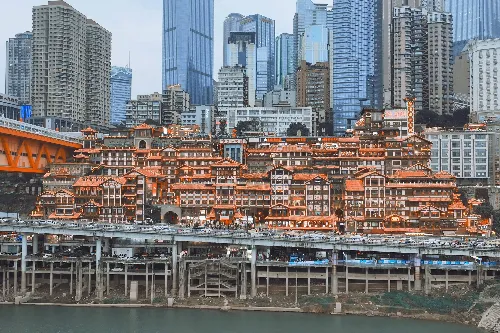
Folk Custom Exhibition Hall
The Folk Custom Exhibition Hall is located inside the scenic area, covering an area of about 800 square meters. It focuses on displaying folk cultural relics, old photos, traditional handicrafts, etc. from the Bayu area. The exhibition hall is divided into areas such as "Bayu Memories", "Folk Customs" and "Intangible Heritage Inheritance". Through physical objects, models, multimedia and other methods, it introduces in detail Chongqing's traditional festivals, wedding and funeral customs, folk arts (such as Shu embroidery, wood carving), etc. Among them, the real-scene simulation experience of Chuanjiang Haozi allows tourists to feel the hardships and heroism of the boat trackers pulling boats in the past, making it an important place to understand Chongqing's folk culture.
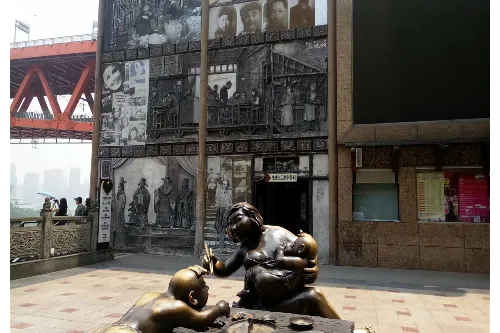
Jialing River Viewing Platform
Jialing River Viewing Platforms are distributed on multiple floors of Hongya Cave, among which the viewing platforms on the 11th and 1st floors have the best view, with a total area of about 500 square meters. Standing on the viewing platform, you can closely enjoy the river view of the Jialing River, the majestic appearance of Qiansimen Jialing River Bridge, and the modern buildings in Jiangbeizui on the opposite bank of the river. It is an excellent location for taking photos of Chongqing's river scenery and urban skyline. Especially in the evening, when the sun sets, the river is sparkling, reflecting with urban buildings, presenting a very charming scene.
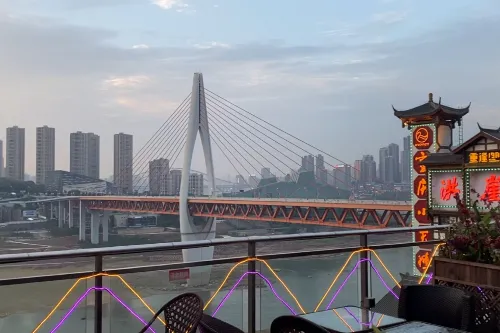
Hongya Dripping Green
"Hongya Dripping Green" is one of the "Twelve Scenes of Bayu", originally referring to the water curtain landscape formed by water seeping from the cliff at Hongya Gate. Now, in the scenic area, a waterfall landscape is artificially created on the cliff. The water flows down from a high place, forming an interesting contrast with the stilted buildings, especially after rain or under the reflection of night lights, it looks more vivid.
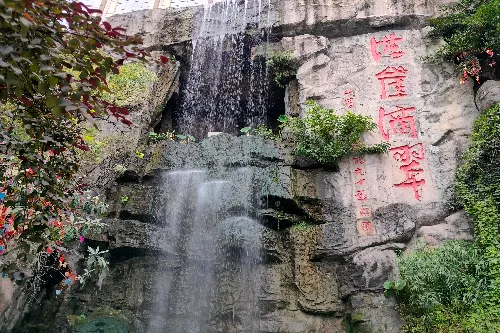
Bayu Style Street
Bayu Style Street is located on the 4th to 6th floors of the scenic area, with a total length of about 300 meters. On both sides of the street, there are many shops and restaurants with Bayu characteristics, following the layout of the old Chongqing commercial street. Here, there are gathered Chongqing hotpot, small noodles, hot and sour noodles and other characteristic food stores, as well as Shu embroidery, paper-cutting, Rongchang pottery and other handicraft stores. Tourists can taste authentic food and buy characteristic souvenirs. There are also folk artists performing Sichuan opera face-changing, sugar painting making, etc. on the street, full of strong Bayu style.
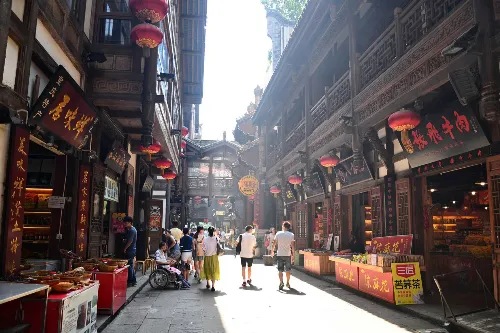
Qiansimen Bridge Viewing Point
Qiansimen Bridge Viewing Point is located on the floor of Hongya Cave near the river, specially set up for viewing Qiansimen Jialing River Bridge. Qiansimen Bridge is an important bridge connecting Yuzhong District and Jiangbei District, with a main span of 312 meters and a bridge tower height of 182.5 meters. It has both road and rail transit functions, with a light and beautiful shape. From the viewing point, the bridge spans the Jialing River, forming a picture of the integration of ancient and modern with the stilted building complex of Hongya Cave. It is a popular location for taking photos of the bridge and Hongya Cave in the same frame, especially at night, when the lights of the bridge and Hongya Cave set off each other, which is extremely beautiful.
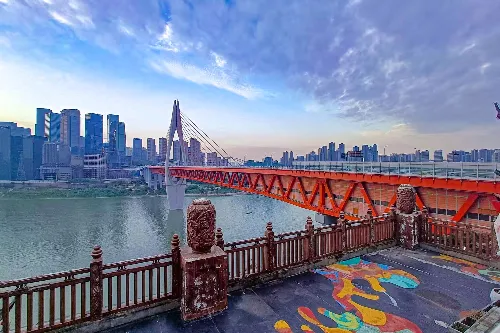
Riverside Viewing Belt
Located on the ground floor of the scenic area, built along the Jialing River, with a total length of about 500 meters. It is an excellent place to enjoy the confluence of the two rivers and the night view of Hongya Cave. You can feel the flow of the river up close or take a cruise to experience the scenery on the river.
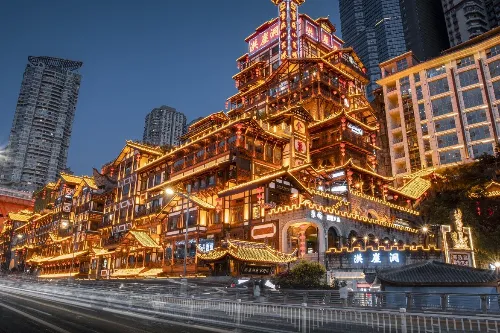
Tour Route
Tourists can enjoy the river view and Qiansimen Bridge at the Jialing River Viewing Platform, then go up to the 4th floor of Bayu Style Street by stairs or elevator to taste Chongqing small noodles and other characteristic snacks, visit handicraft stores, and watch folk artists' performances. Then go to the Folk Custom Exhibition Hall to learn about Bayu folk culture, and then continue to go up to the top viewing platform on the 11th floor to overlook the entire building complex and urban landscape. In the evening, return to the riverside viewing area on the lower floor, wait for the night lights to turn on, and enjoy the night view of Hongya Cave and Qiansimen Bridge. The total length of the tour route is about 1.5 kilometers, and the walking time is about 2-3 hours. If you want to experience food and shopping in depth, you can appropriately extend the visiting time.
Tour Suggestions
- The temperature is suitable in spring and autumn (March-May, September-November). It is necessary to prevent heatstroke in summer (June-August) and pay attention to wind protection in winter (December-February). It is recommended to visit after 18:00 to avoid the peak flow of people and enjoy both day and night views.
- Take a panoramic photo of Hongya Cave on Qiansimen Bridge with a wide-angle lens; turn on the mobile phone night mode when shooting on Binjiang Road to avoid overexposure due to strong light.
- There are fewer tourists on weekdays. The peak visiting time is 19:00-21:00 on weekends and holidays. It is recommended to visit the upper blocks first and then go down layer by layer.
- The price of souvenirs in the scenic area is relatively high, so you can compare multiple stores; it is recommended to go to local neighborhoods such as Jiaochangkou and Shihuishi for food, which are more cost-effective.
- It is recommended to arrange the visiting time from afternoon to evening, so that you can experience the architectural style during the day and enjoy the light night view. The best time to enjoy the night view is 19:30-21:30.
- The catering in the scenic area is mainly Chongqing characteristic food. It is recommended to try hotpot, small noodles, hot and sour noodles, Chen mahua, etc. There are more choices in the food blocks on the 4th to 6th floors.
- The best place to take a panoramic photo of Hongya Cave is Jiangbeizui River Beach Park or Qiansimen Bridge on the opposite bank of the river, which you can go to after visiting.
- There are many steps and stairs in the scenic area, so it is recommended to wear comfortable flat shoes for easy walking.
Matters Needing Attention
- The stairs in the scenic area are steep and there are many people, so pay attention to anti-slip and foot safety; the guardrail of Binjiang Road is low, do not climb over it for taking photos.
- Smoking is prohibited in the wooden structure area of stilted buildings to avoid open fire; put garbage into designated trash cans to keep the scenic area clean.
- It is recommended to buy tickets for the Two Rivers Cruise through official channels to avoid scalpers; rainy days may affect the operation of the cruise, so check the weather in advance.
- Self-driving: The surrounding roads are seriously congested from 18:00 to 20:00 on weekends, so priority should be given to rail transit; it is necessary to reserve more than 15 minutes for transfer at Xiaoshizi Metro Station.
- When there are many people, take good care of personal belongings, especially mobile phones, wallets and other valuables, to prevent loss or theft.
- When going up and down stairs and walking in the corridor, pay attention to foot safety, avoid crowding, and take good care of the elderly and children.
- Some shops in the scenic area may have relatively high prices. You can learn about the market price in advance before shopping and consume rationally.
- When viewing the scenery at night, do not climb over the guardrail, and watch in the designated area to ensure personal safety.
- In case of extreme weather (such as heavy rain, strong wind), some open viewing areas may be temporarily closed, so follow the guidance of the staff.
Transportation
- Rail transit: Take Line 6 to Xiaoshizi Station, exit from Exit 5, and walk about 300 meters to the entrance of the 11th floor of the scenic area.
- Bus: Take No. 111, 151, 466, etc. to Xiaoshizi Station, or take No. 608, 881 to Hongya Cave Station.
- Self-driving: Navigate to "Hongya Cave Folk Scenic Area". There are Huguang Guild Hall Parking Lot, Daijia Lane Parking Lot, etc. around. Parking spaces are tight. It is recommended to arrive before 19:00. The parking fee is about 10-20 yuan per hour.
- On foot: It is about 800 meters (10 minutes) walk from Jiefangbei Pedestrian Street, and you can visit Bayi Food Street along the way.
Opening Hours
The opening hours are 11:00-23:00, among which the business hours of shops and catering establishments are mostly 10:00-22:30. During holidays (such as Spring Festival, National Day), the opening hours may be extended to 23:30, subject to the announcement of the scenic area on that day.
Tickets
The scenic area is open for free, but some special venues or projects require tickets. For example, the price of the Two Rivers Cruise tickets varies by ship type, with ordinary ships about 100-150 yuan per person and luxury ships about 200-300 yuan per person.
Online Booking
Click here to jump to the Trip.com ticketing platform for ticket purchase.


